Troubleshooting a Wanner™ Hydra-Cell® Pro Pump
Common causes for poor pump performance
 Troubleshooting Hydra-Cell pumps
Troubleshooting Hydra-Cell pumps
Wanner™ Hydra-Cell® Pro pumps are a uniquely designed sealless
positive displacement pump which provide extremely reliable service for many
years of continuous operation. There are times when your pump is not
performing as required and this article will provide some troubleshooting
guidelines to help get your pump functioning to its full potential.
Context
matters
Troubleshooting existing applications where the pump was once
performing well differs from a new installation where you have no experience.
In the first case it can initially be assumed that your inlet and outlet
plumbing is acceptable and that the issue is related to the pump or pressure
regulating valve. Trouble with new installations are almost entirely
related to the inlet plumbing of your pump. Likewise, if an existing
system recently underwent some plumbing changes before performance changed its
an indication that your inlet condition might have some issues.
Troubleshooting
an existing application
Hydra Cell Pro pumps require periodic maintenance which
includes oil changes and replacement of the fluid end components – mainly the
check valves. The only components in contact with the pumped fluid are the
pair of check valves for each pump chamber and the elastomers (diaphragms and
o-rings). If your fluid is aggressive to your elastomers, they may need
periodic replacement, but that is atypical. The diaphragms and o-rings are
generally not worn or damaged by normal use even with the fluid is an abrasive
slurry. We pump TIO2, lime slurry, carbon slurry, ceramic slip and a
range of very abrasive fluids which really have little effect on our elastomers.
Check Valve Components
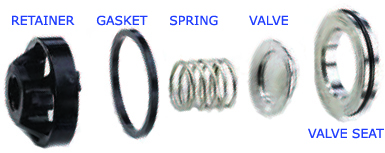
The most common existing application trouble you will experience is a pump
running rough as noted by a pulsing flow or pressure and typically the
flow/pressure is less than what it originally was. As a positive
displacement pump, Hydra-Cell’s displace a fixed volume of fluid of which
pressure is a result of resistance to that flow rate. When your
check valves wear it means they are not sealing as well as they once did and
that enables some of the flow that is meant to exit the pump via the outlet
actually pulses back into the inlet. This variance in flow rate is
confirmed visually by a pressure gauge pointer that is normally steady but now
fluctuates significantly. Often the worn check valve components are the
valve and seat because where they interface wears down after many hours of use.
In some reclaimed fluid applications such as pumping machine tool coolant at
high pressure, stainless steel check valves might last 6500+ hours whereas
ceramic check valves might only last 1000 hours when pumping 25% lime slurry for
flue gas conditioning applications. The material of the check valves will
affect the frequency of their replacement.
The other components of the check
valve assembly are the spring, spring retainer (compresses the spring), an
o-ring, gasket and sometimes a dampening washer. These components do not
normally “wear” or “break” although we have had customers damage them due to
upset conditions. An example would be a fluid temperature exceeding 150°F
could result in deformation of the dampening washers or spring retainers if they
are made of a non-alloy material. A pump operating with very worn check
valves could result in a broken check valve spring or retainer because the wear
enables these components to move around. Anything which effects the
ability of the check valve to open, close and seal properly will result in a
reduction in flow rate/pressure. The check valve kit for Hydra Cell Pro pumps
enables you to replace all of the check valve components and you do not require
any special tools or skills to do so. Most Hydra Cell Pro pumps can have
their check valves replaced within 1 hour and you can do it without removing the
pump from where it is installed if the space permits.
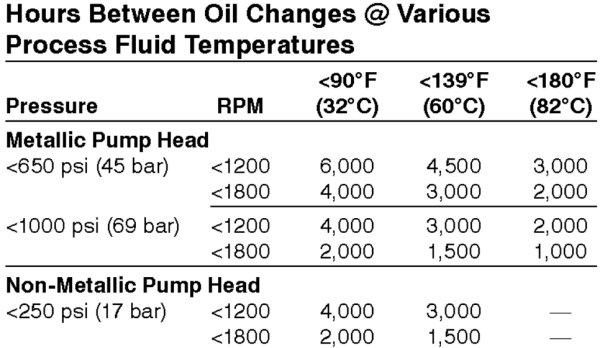 Lack of oil changes can
contribute to wear of the hydraulic end components, these are the pump
components not exposed to the pumped fluid. The frequency of oil
changes varies by pump model and is related to the operating pressure; 4000 to
6000 hours is typical for most applications. When we troubleshoot an existing
Hydra-Cell pump application we start with the oil; we examine it to ensure:
Lack of oil changes can
contribute to wear of the hydraulic end components, these are the pump
components not exposed to the pumped fluid. The frequency of oil
changes varies by pump model and is related to the operating pressure; 4000 to
6000 hours is typical for most applications. When we troubleshoot an existing
Hydra-Cell pump application we start with the oil; we examine it to ensure:
-
there is no process fluid mixed within (indication of damaged diaphragm)
-
oil level is not too low (indicates loss of oil through diaphragm, housing or vent cap)
-
oil does not contain an excessive amount of metal fines (excessive wear of hydraulic end components requiring factory or skilled service). A few bits of silvery fines are okay/normal but for the most part worn oil should look uniformly black.
If the oil looks good and the pump had been working well for
some time then installing a replacement valve kit or complete overhaul kit
(includes elastomers) coupled with an oil change should get your pump running
like new. If specific damage related to an upset condition is observed,
then the process should be reviewed to see if an upgrade in pump materials or
process control is warranted.
The pump elastomers can be damaged by chemical
incompatibility, excessive temperature, over-pressurization and in very rare
circumstances a sharp object becoming stuck in the pump chamber. Likewise,
it is possible to jam open one of the inlet check valves with foreign material
and the resulting performance would mimic a worn check valve. The length
of acceptable operation is key to speculation as to if the erratic performance
is due to an upset condition or normal wear.
One customer let water
freeze within the pump head which resulted in cracking the pump housing and
damaging the diaphragms when they tried running the pump with ice chunks within
the pump chamber.
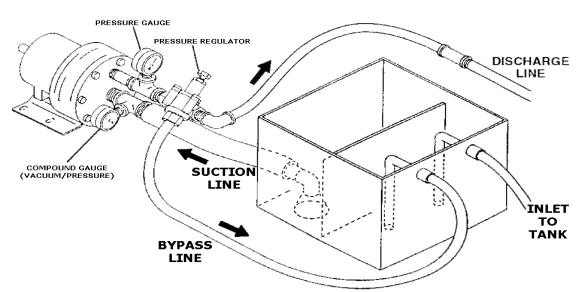 Troubleshooting new applications
Troubleshooting new applications
Since all
Hydra Cell Pro
pumps are factory tested at their full flow rate and pressure prior to shipment
it is extremely likely that a new pump not performing as expected is related to
its inlet condition. Since Hydra Cell Pro pumps displace a fixed volume of
fluid per rotation and a new pump has perfectly functioning check valves,
elastomers and new oil, the most common reason the pump isn’t outputting enough
flow/pressure is that there simply isn’t enough fluid available for the pump to
displace. Although Hydra Cell Pro pumps can self-prime and have some suction
lift capability, inlet plumbing can result in less NPSHa than NPSHr (net
positive suction head available vs required). Each pumps’
IOM manual contains curves illustrating NPSHr as well as formulas to calculate
NPSHa based upon your specific design. The most common plumbing issues are
an undersized feed tank and/or undersized inlet pipe, clogged or otherwise
restrictive filter and aeration of the pumped fluid due to the process of
filling the feed tank or the plumbing of the pressure regulating valve.
Sometimes the issue is tricky to figure-out such as when everything works fine
with a full feed tank and rougher when the tank is at a lower level.
Hydra-Cells fed with a pressurized line can have aeration issues as well which
are related to high velocity flow and resulting turbulence when elbows and other
fittings are near the pump inlet.
It is helpful for troubleshooting purposes if a
compound pressure gauge is installed on the pump inlet and a standard liquid
filled gauge is installed on the pump outlet to quickly assess if there’s
positive inlet pressure coming to the pump and to judge the steadiness of the
flow rate. Another trouble shooting technique is to disconnect the pump
outlet from its piping and measure the flow rate of the pump. If it is
lower than it is supposed to be, meaning the pump is trying to pump more fluid
than available, it will be cavitating, creating a lot of implosion noises and
your issue is definitely related to your inlet condition.
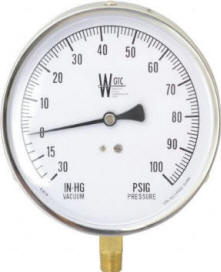 Low or “no” pressure
Low or “no” pressure
Since
pressure is a result of restriction to the flow rate, low or “no” pressure for a
system having a good inlet condition is related to one of the following:
-
The pump shaft RPM is not correct and this can happen due to incorrect belt/pulley selection and improper wiring of your motor.
-
The outlet “restriction”, perhaps spray nozzles, a machine tool, pump seal or whatever it may be, is too large to result in the desired back-pressure. Spray nozzles are subject to wear and their manufacturing tolerances can be as wide as ±10% of the stated flow rate. If this is your problem the pump is “undersized” for your outlet condition.
-
Something has been sucked-up and jammed open one or more inlet check valves, an upset condition uniquely associated with start-up of new pump systems and can involve things like PTFE thread sealant tape, “plumber’s putty” and weld debris.
-
The system is air locked, meaning that due to the compressibility of air within the pump chamber, insufficient fluid enters the pump to be displaced. This is rectified by reducing the outlet pressure required for the first 30 seconds or so until the air is flushed from the pumping chambers by adjusting the pressure regulating valve to its lowest setting or installing our air bleed valve at the pump outlet.
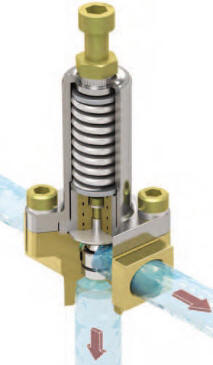
Don’t forget your pressure
regulating valve
Sometimes the culprit for a low-pressure situation is the
pressure regulating valve, either not set correctly or its valve/seat is worn.
The valve/seat of your pressure regulating valve does not typically wear as
quickly as the pumps check valves, but they do eventually wear and when they do
it results in an “invisible leak”, enabling bypass of fluid – sending less to
the outlet/restriction and thus there’s a drop in pressure. This type of
pressure loss is often not fluctuating and its gradual. Usually, personnel
keep tightening the PRV to maintain pressure until it can no longer be
compensated for, so its another aspect to consider, especially for existing
systems which have operated fine previously.
Assistance with a new or existing
pump application is a quick phone call or email away and we will put our
experience to work for you!
Wanner™ is a trademark and Hydra-Cell® is a registered trademark of Wanner Engineering, Inc.




